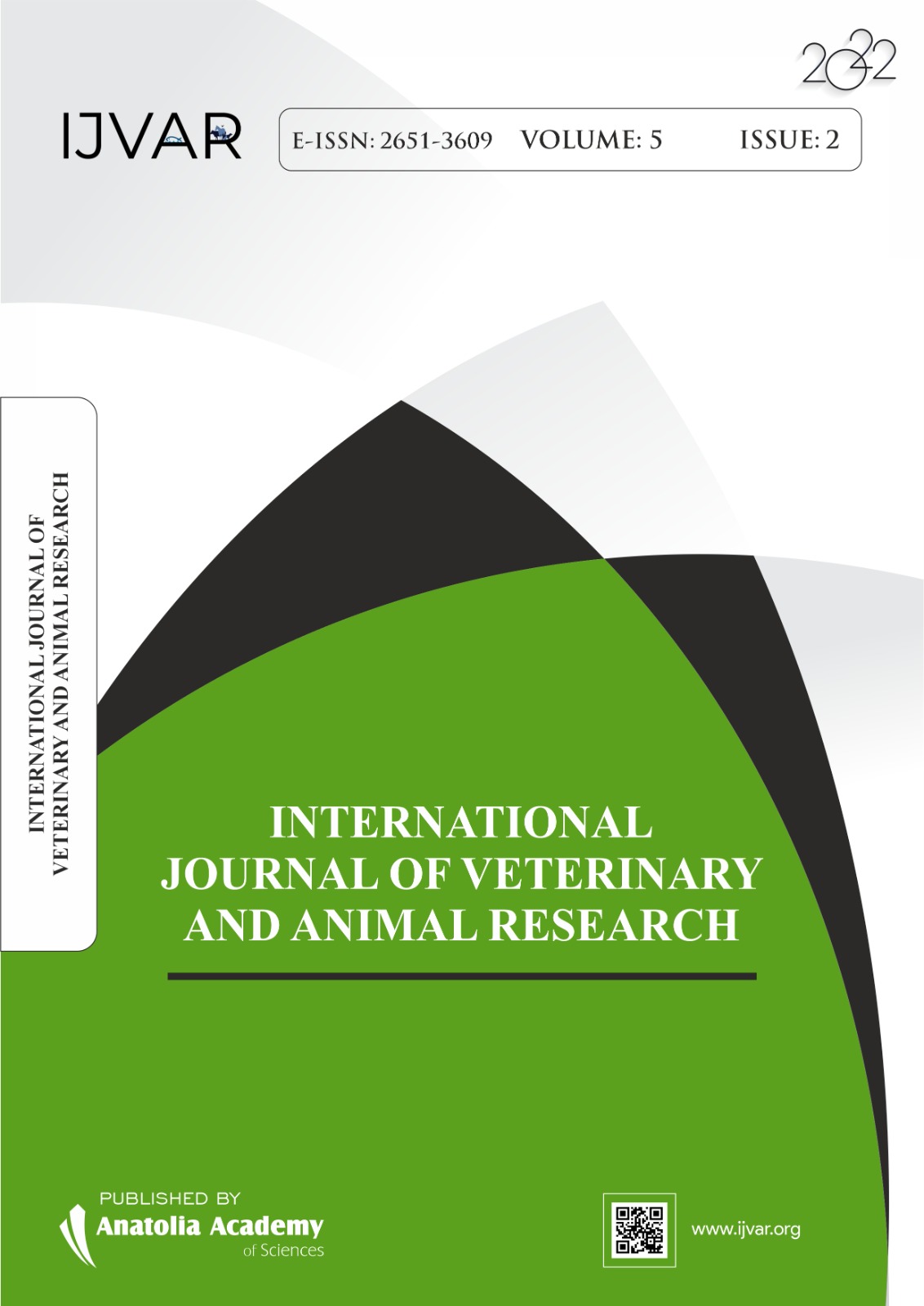The Effects of Some Feed Additives in Nutrition of Ruminant Animals
Keywords:
Review, feed additive, pre/probiotic, ruminantAbstract
In this review, the use of some feed additives in the diets of ruminant animals is discussed. Brief information about the anatomy of the digestive system of ruminants and the metabolism of some nutrients in these animals are presented. In addition, summary information about some feed additives used in animal nutrition is given. Particularly detailed information about pre/probiotics among feed additives is presented, and the effects of S. cerevisiae, known as yeast, are discussed. In ruminant animals, unlike the monogastrics, feed additives, especially pre-and probiotics, are utilized to affect fermentation in the rumen. In addition, it is seen that it is used to increase immunity in pre-ruminants. However, it is obvious that more studies are needed on these issues.
References
Adjei-Fremah S, Ekwemalor K, Worku M, Ibrahim S. 2018. Probiotics and Ruminant Health, in: Enay S. (Ed), Current Knowledge and Future Prospects. IntechOpen, DOI: 10.5772/intechopen.72846. https://www.intechopen.com/chapters/58507. Date of visit, 17.08.2021.
Ahiwe E, Tedeschi Dos Santos TT, Graham H, and Iji P. 2021. Can probiotic or prebiotic yeast Saccharomyces cerevisiae) serve as alternatives to in-feed antibiotics for healthy or disease-challenged broiler chickens, The journal of applied poultry research, 30(9):100-164, DOI: 10.1016/j.japr.2021.100164.
Amin AB, and Mao S. 2020. Influence of yeast on rumen fermentation, growth performance and quality of products in ruminants: A review. Animal nutrition, 7(1): 31-41.
Anadón A, Ares I, Martínez-Larrañaga MR, and Martínez M. 2019. Prebiotics and probiotics in feed and animal health, in: Gupta RC, Srivastava A, Lall R. (Eds), Nutraceuticals in Veterinary Medicine. Springer.
Anonimous A. 2021. Types of Animal Digestive Systems.http://www.mishicotffa.org/uploads/2/3/2/7/23271034/2._digestion_eunit.pdf. Date of visit, 17.08.2021.
Anonimous B. 2021. A brief Idea About Carbohydrate Metabolism. http://www.midnaporecollege.ac.in/RemoteClass/Carbohydrate%20metabolism_UG%20VI.pdf. Date of visit, 17.08.2021.
Anonimous C. 2021. Metabolism of carbohydrates. https://bio.libretexts.org/Bookshelves/Microbiology/Book%3A_Microbiology_(Boundless)/2%3A_Chemistry/2.6%3A_Energy/2.6.1%3A_Metabolism_of_Carbohydrates. Date of visit, 04.01. 2021
Anonimous D. 2021. Protein Metabolism. http://www.midnaporecollege.ac.in/RemoteClass/Protein%20metabolism%20MB%20Madam.pdf. Date of visit, 17.08.2021
Bermudez-Brito M, Plaza-Díaz J, Muñoz-Quezada S, Gómez-Llorente C, Gil A. 2012. Probiotic mechanisms of action. Annals of nutrition & metabolism, 61:160–174
Cherian G. 2021. A Guide to the Principles of Animal Nutrition. Oregon State University. https://open.oregonstate.education/animalnutrition/chapter/chapter-19/. Date of visit 20.08.2021
Church DC. 1993. The Ruminant Animal: Digestive Physiology and Nutrition. Waveland Press, Long Grove, IL.
Ergün A, Tuncer ŞD, Çolpan İ, Yalçın S, Yıldız G, M. Küçükersan K, Küçükersan S, Şehu A. 2001. Hayvan Besleme ve Beslenme Hastalıkları. Medipress, Ankara.
Markowiak P, and Sliżewska K. 2018. The role of probiotics, prebiotics and synbiotics in animal nutrition. Gut Pathog, 10:21. https://doi.org/10.1186/s13099-018-0250-0.
Pandey AK, Kumar P and Saxena MJ. 2019. Feed Additives, in: Gupta RC, Srivastava A, Lall R. (Eds), Nutraceuticals in Veterinary Medicine. Springer.
Parish JA, Rivera JD and Boland HT. 2017. Understanding the Ruminant Digestive System, Mississippi State University, MS.
Retta KS. 2016. Role of probiotics in rumen fermentation and animal performance: A review. International journal of livestock production, 7(5): 24-32.
Samanta AK, Jayapal N, Senani S, Kolte AP, and Sridhar M. 2013. Prebiotic inulin: Useful dietary adjuncts to manipulate the livestock gut microflora. Brailian journal of microbiolgy, 44(1): 1–14. 44(1): 1–14.
Sethy K, Dhaigude V, Dwibedy P, Mishra BK, Vaidantika V, Priyadarshinee P, Debata NR and Adhikary PD. 2017. Prebiotics in animal feeding. The pharma innovation journal, 6(11): 482-486.
Sontakke M. 2012. Benefits of Saccharomyces cerevisiae as a feed additive in ruminants. https://en.engormix.com/dairy-cattle/articles/saccharomyces-cerevisiae-in-ruminants-nutrition-t35453.htm. Date of visit 20.08.2021.
Teng PY and Kim WK. 2018. Review: Roles of prebiotics in intestinal ecosystem of broilers. Frontiers in Veterinary Science, 3:1-18.
Van Saun RJ. 2014. Feeds for camelids, in: Cebre C, Anderson DE, Tibary A, Van Saun RJ, Johnson LW. (Eds), Llama and Alpaca Care Medicine, Surgery, Reproduction, Nutrition, and Herd Health. Elsevier Inc.
Watts SA, Lawrence JM. 2020. Sea urchins: biology and ecology, in: Lawrence JM. (Ed), Developments in Aquaculture and Fisheries Science. Elsevier Inc.
Yirga H. 2015. The use of probiotics in animal nutrition. Journal of probiotics & health, 3(2): 1-10. doi:10.4172/2329-8901.1000132.
Downloads
Published
How to Cite
Issue
Section
License
Copyright (c) 2022 International Journal of Veterinary and Animal Research (IJVAR)

This work is licensed under a Creative Commons Attribution-NonCommercial-NoDerivatives 4.0 International License.







